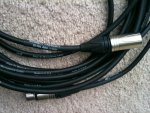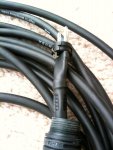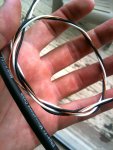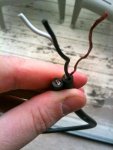Zane Kadro, formerly with 4 Star Wire and Cable (who made a great road worthy Ethernet cable I reviewed on the LAB) has started his own company, Jumperz, making cable and assemblies. He sent me a 25' mic cable using their 2 conductor 20 gauge unshielded cable with drain wire, supposed to be extremely flexible and easy to handle. I have spent some time with it and submit my thoughts for your consideration.

First impressions are that the custom shrink wrap is a very slick touch. The cable feels nice and appears durable. Neutrik connectors on both ends are the default, and my preference. Even after spending days in transit coiled up, the cable uncoils with a single throw. I can wrap it up about as quickly as I can move my hands. It falls nicely and is, as advertised, very easy to handle, very flexible, and nice to work with. Definitely feels like a high end pro cable. I have tried to think of a way to describe its behavior and I think the way to describe it is "springlike". The whole cable appears to have low memory and slides around itself well, resisting knotting.
 Taking off one connector reveals attention to detail, careful shrink wrapping. This looks slick, but of course would have to be cut out of the way to diagnose any cable faults or perform any repairs. Personally I'd rather the solder points were visible. The cable jacket itself is so flexible that it may be good practice to have some shrink wrap at either end where the strain relief on the connector bites down to keep it from squirreling out, and in any case the custom shrink wrap seems to be the way to go. I would just shorten it by 1/2" at the connector side.
Taking off one connector reveals attention to detail, careful shrink wrapping. This looks slick, but of course would have to be cut out of the way to diagnose any cable faults or perform any repairs. Personally I'd rather the solder points were visible. The cable jacket itself is so flexible that it may be good practice to have some shrink wrap at either end where the strain relief on the connector bites down to keep it from squirreling out, and in any case the custom shrink wrap seems to be the way to go. I would just shorten it by 1/2" at the connector side.
 I had Zane send me a short length of the cable unterminated so I could tear it apart, since I'd like to keep my 25 footer functional so I can continue to use it! The twin 20GA conductors are nice and heavy, whether that matters or not is certainly questionable, but a little extra copper never hurt anyone and makes me feel nice about the ability of the cable to take a good beating. The real question, in my mind, pertains to the shielding and drain/ground wire. The shielding has been omitted to save flexibility. The effects of this are obvious in the handling of the cable. Personally, I don't really care about the shielding. It would have to be one hell of an adverse condition for it to matter. Considering that the nation's telephone infrastructure and much of its data infrastructure relies on simple twisted pairs to reject noise I am not going to waste much, if any, thought on the lack of a shield.
I had Zane send me a short length of the cable unterminated so I could tear it apart, since I'd like to keep my 25 footer functional so I can continue to use it! The twin 20GA conductors are nice and heavy, whether that matters or not is certainly questionable, but a little extra copper never hurt anyone and makes me feel nice about the ability of the cable to take a good beating. The real question, in my mind, pertains to the shielding and drain/ground wire. The shielding has been omitted to save flexibility. The effects of this are obvious in the handling of the cable. Personally, I don't really care about the shielding. It would have to be one hell of an adverse condition for it to matter. Considering that the nation's telephone infrastructure and much of its data infrastructure relies on simple twisted pairs to reject noise I am not going to waste much, if any, thought on the lack of a shield.
What concerns me is having a ground wire at all, given no shield for it to "drain" current from. The cable is relying entirely on the properties of twisted pair wiring and balanced drivers and receivers to reject noise. This works great, and there is some validity in suggesting that having a third conductor to connect the grounds of two separate devices can do little but cause trouble. What I am talking about is Shield Current Induced Noise (SCIN), the effects of which have been well documented by Jim Brown. The gist of the problem is that by introducing a third conductor inside the jacket, you have harmed the twisted pair because now you have a noise current carrying conductor that is going to be on average closer to one signal carrying conductor than the other. That signal carrying conductor will pick up this noise through the effects of a parasitic transformer more than the other conductor. The balanced line receiver will see more noise on one conductor than the other and let it through, since it is only trained to eliminate whatever is identical between the conductors. This is how balanced lines work, use twisted pair to try and get noise sources to generate noise in both conductors equally, and then throw out whatever is the same.
This is the very reason that I prefer braid shielded cable. Foil shield cable has that pesky drain conductor. Braid may not offer 100% coverage, but I don't think that's really an issue. It does not suffer from SCIN as it wraps both signal carrying conductors evenly. Plus, it's more flexible than foil shields.
Anyway, long story short, this is excellent and very flexible cable. I have used it several times for test and measurement and it has worked. I would have no qualms using it on stage, and would certainly appreciate wrapping it up at the end of the day. You must evaluate for yourself what you feel the effects of the drain wire and no shield are. I'd be just as happy with a 2 conductor cable, period, no ground path whatsoever. Of course, in the event of a lost leg or if trying to interconnect unbalanced equipment that could post a problem, and that is probably why it was included in the first place.

First impressions are that the custom shrink wrap is a very slick touch. The cable feels nice and appears durable. Neutrik connectors on both ends are the default, and my preference. Even after spending days in transit coiled up, the cable uncoils with a single throw. I can wrap it up about as quickly as I can move my hands. It falls nicely and is, as advertised, very easy to handle, very flexible, and nice to work with. Definitely feels like a high end pro cable. I have tried to think of a way to describe its behavior and I think the way to describe it is "springlike". The whole cable appears to have low memory and slides around itself well, resisting knotting.
 Taking off one connector reveals attention to detail, careful shrink wrapping. This looks slick, but of course would have to be cut out of the way to diagnose any cable faults or perform any repairs. Personally I'd rather the solder points were visible. The cable jacket itself is so flexible that it may be good practice to have some shrink wrap at either end where the strain relief on the connector bites down to keep it from squirreling out, and in any case the custom shrink wrap seems to be the way to go. I would just shorten it by 1/2" at the connector side.
Taking off one connector reveals attention to detail, careful shrink wrapping. This looks slick, but of course would have to be cut out of the way to diagnose any cable faults or perform any repairs. Personally I'd rather the solder points were visible. The cable jacket itself is so flexible that it may be good practice to have some shrink wrap at either end where the strain relief on the connector bites down to keep it from squirreling out, and in any case the custom shrink wrap seems to be the way to go. I would just shorten it by 1/2" at the connector side. I had Zane send me a short length of the cable unterminated so I could tear it apart, since I'd like to keep my 25 footer functional so I can continue to use it! The twin 20GA conductors are nice and heavy, whether that matters or not is certainly questionable, but a little extra copper never hurt anyone and makes me feel nice about the ability of the cable to take a good beating. The real question, in my mind, pertains to the shielding and drain/ground wire. The shielding has been omitted to save flexibility. The effects of this are obvious in the handling of the cable. Personally, I don't really care about the shielding. It would have to be one hell of an adverse condition for it to matter. Considering that the nation's telephone infrastructure and much of its data infrastructure relies on simple twisted pairs to reject noise I am not going to waste much, if any, thought on the lack of a shield.
I had Zane send me a short length of the cable unterminated so I could tear it apart, since I'd like to keep my 25 footer functional so I can continue to use it! The twin 20GA conductors are nice and heavy, whether that matters or not is certainly questionable, but a little extra copper never hurt anyone and makes me feel nice about the ability of the cable to take a good beating. The real question, in my mind, pertains to the shielding and drain/ground wire. The shielding has been omitted to save flexibility. The effects of this are obvious in the handling of the cable. Personally, I don't really care about the shielding. It would have to be one hell of an adverse condition for it to matter. Considering that the nation's telephone infrastructure and much of its data infrastructure relies on simple twisted pairs to reject noise I am not going to waste much, if any, thought on the lack of a shield.What concerns me is having a ground wire at all, given no shield for it to "drain" current from. The cable is relying entirely on the properties of twisted pair wiring and balanced drivers and receivers to reject noise. This works great, and there is some validity in suggesting that having a third conductor to connect the grounds of two separate devices can do little but cause trouble. What I am talking about is Shield Current Induced Noise (SCIN), the effects of which have been well documented by Jim Brown. The gist of the problem is that by introducing a third conductor inside the jacket, you have harmed the twisted pair because now you have a noise current carrying conductor that is going to be on average closer to one signal carrying conductor than the other. That signal carrying conductor will pick up this noise through the effects of a parasitic transformer more than the other conductor. The balanced line receiver will see more noise on one conductor than the other and let it through, since it is only trained to eliminate whatever is identical between the conductors. This is how balanced lines work, use twisted pair to try and get noise sources to generate noise in both conductors equally, and then throw out whatever is the same.

This is the very reason that I prefer braid shielded cable. Foil shield cable has that pesky drain conductor. Braid may not offer 100% coverage, but I don't think that's really an issue. It does not suffer from SCIN as it wraps both signal carrying conductors evenly. Plus, it's more flexible than foil shields.
Anyway, long story short, this is excellent and very flexible cable. I have used it several times for test and measurement and it has worked. I would have no qualms using it on stage, and would certainly appreciate wrapping it up at the end of the day. You must evaluate for yourself what you feel the effects of the drain wire and no shield are. I'd be just as happy with a 2 conductor cable, period, no ground path whatsoever. Of course, in the event of a lost leg or if trying to interconnect unbalanced equipment that could post a problem, and that is probably why it was included in the first place.

